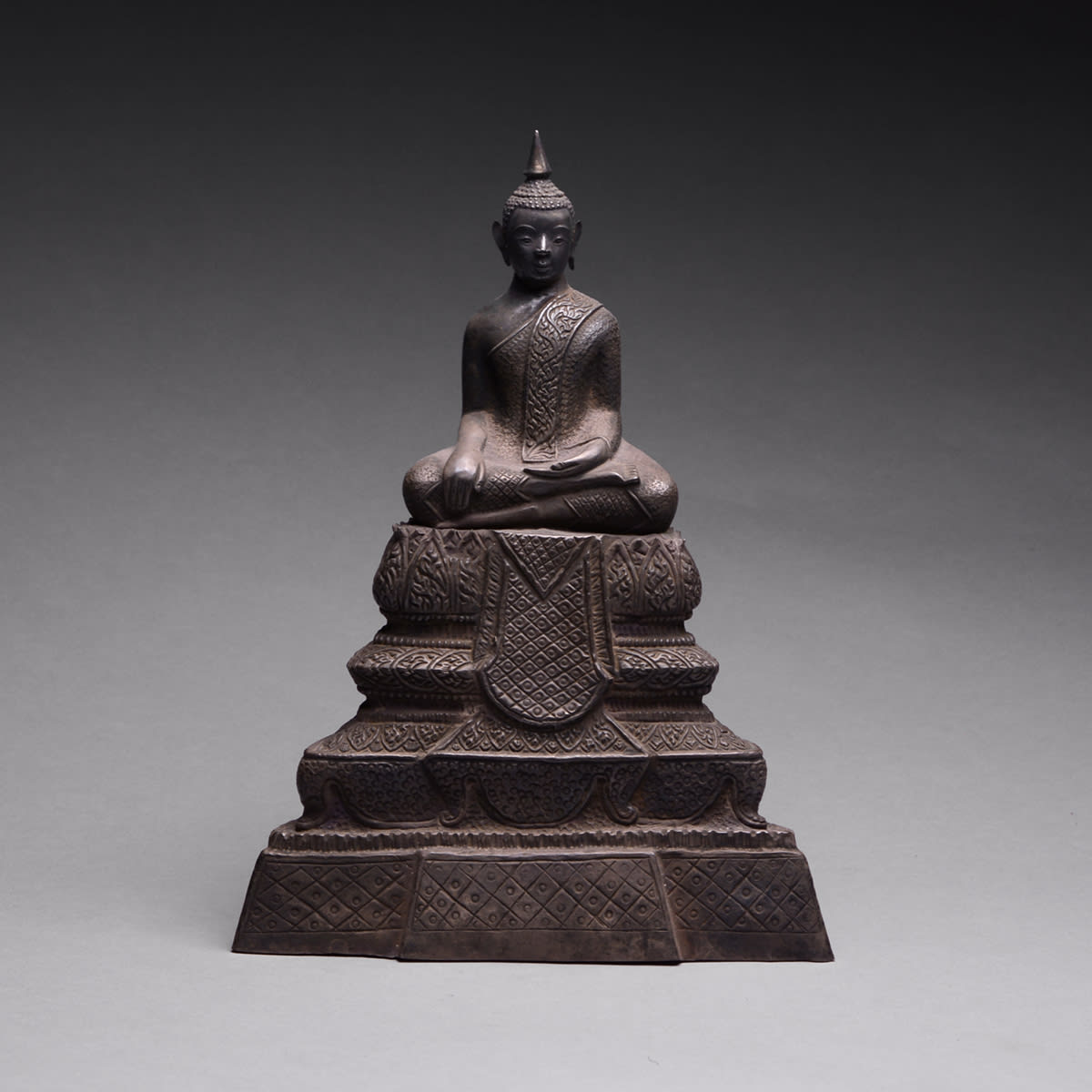Cambodian Silver Sculpture of the Buddha, 1871 CE
Silver
height 25.1 cm
height 9 7/8 in
height 9 7/8 in
FZ.422
Further images
This striking silver Buddha dates to one of the most troubled and dynamic periods of Cambodian history. After the fall of Angkor and the great Khmer Empire in the 15th...
This striking silver Buddha dates to one of the most troubled and dynamic periods of Cambodian history. After the fall of Angkor and the great Khmer Empire in the 15th Century, Cambodia fell under the control of the Thai until the French granted independence in 1953. In many senses the piece looks back towards the Golden age of Khmer civilization, when the kingdom of Kambuja ruled vast territories from its capital in the region of Angkor in western Cambodia. The empire was enlarged at considerable cost to neighbouring Vietnam and the Cham peoples, but Khmer cultural creativity and artistic production was admired throughout the region. However, socioeconomic deterioration saw the gradual collapse of this great empire in the 15th century. The so-called Dark ages were characterised by the Cambodia’s increasing powerlessness to prevent being used as a pawn in the struggles between Vietnam and Siam (Thailand), which resulted in annexation of rich mineral and agricultural lands and a resulting impoverishment of the populace. Partly to stave off a total defeat at the hands of their voracious neighbours, Cambodia signed a treaty with France that was designed to provide revenue for the latter, and protection for the former. While the exact terms of the deal were amended to Cambodia’s cost, the effect was positive. Perhaps most significantly, from our point of view, they retained a highly active and creative artistic and cultural identity, which is manifested in the current piece.
This silver sculpture of the Buddha reveals the influence of foreign cultures on the art of Cambodia. Thailand, which began as a breakaway province of the Khmer Empire with the establishment of the Sukhothai Kingdom in 1238, was initially artistically and culturally indebted to the Khmer. By the time this sculpture was created however, the art of Cambodia had come to reflect Thai artistic trends. Here, the Buddha is seated in the Vajraparyanka lotus posture (Padmasana) resting his arms in the Bhumisparsa mudra, or “gesture of touching the earth.” A symbol of unshakable faith and resolution, this mudra portrays the Buddha taking the earth as his witness. The Buddha is seated upon a high, tiered, triangular lotus throne. Highly ornamented with incised stylised foliage and partially covered in a draped fabric, this type of pedestal is characteristic of Thai Buddhas. Furthermore, the modeling of the Buddha himself is related to the art of Thailand, specifically the Buddha’s tightly curled hair and the flame of enlightenment that rises out of his ushnisa. This precious work, rendered in silver atop an earthen core and featuring an inscription on its back, was used as a means for reflective focus. Today, it stands as a beautiful testament to the tumultuous history of Cambodia and the spiritual beliefs of her people.
The inscription on the reverse dates this piece to the Buddhist year 2414, equivalent to 1871.
This silver sculpture of the Buddha reveals the influence of foreign cultures on the art of Cambodia. Thailand, which began as a breakaway province of the Khmer Empire with the establishment of the Sukhothai Kingdom in 1238, was initially artistically and culturally indebted to the Khmer. By the time this sculpture was created however, the art of Cambodia had come to reflect Thai artistic trends. Here, the Buddha is seated in the Vajraparyanka lotus posture (Padmasana) resting his arms in the Bhumisparsa mudra, or “gesture of touching the earth.” A symbol of unshakable faith and resolution, this mudra portrays the Buddha taking the earth as his witness. The Buddha is seated upon a high, tiered, triangular lotus throne. Highly ornamented with incised stylised foliage and partially covered in a draped fabric, this type of pedestal is characteristic of Thai Buddhas. Furthermore, the modeling of the Buddha himself is related to the art of Thailand, specifically the Buddha’s tightly curled hair and the flame of enlightenment that rises out of his ushnisa. This precious work, rendered in silver atop an earthen core and featuring an inscription on its back, was used as a means for reflective focus. Today, it stands as a beautiful testament to the tumultuous history of Cambodia and the spiritual beliefs of her people.
The inscription on the reverse dates this piece to the Buddhist year 2414, equivalent to 1871.









